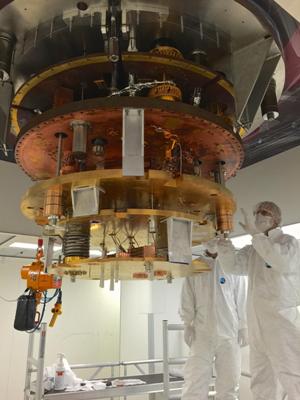An international team of scientists, including postdoctoral scholars and students from the US and Italy, has developed a -273.144°C cooled chamber for a prospective experiment to study ghostlike particles known as neutrinos.
This work was supported by the Cryogenic Underground Observatory for Rare Events (CUORE) in collaboration with the US Department of Energy's Office of Science and National Science Foundation in the US Lawrence Berkeley National Lab.
 Scientists inspect the cryostat of the of the Cryogenic Underground Observatory for Rare Events. Credit: CUORE collaboration
Scientists inspect the cryostat of the of the Cryogenic Underground Observatory for Rare Events. Credit: CUORE collaboration
The chamber, approximately the size of a vending machine is called a cryostat, and it was held in an ultra-cold state for over a fortnight. This massive cryostat is a result of almost ten years of hard work by the team, ironing out the kinks and illustrating its record-breaking performance.
“We've been building this experiment for almost ten years. This is a tremendous feat of cryogenics. We've exceeded our goal of 10 milliKelvin. Nothing in the universe this large has ever been as cold." said Yury Kolomensky, senior faculty scientist in the Physics Division of Berkeley Lab, professor of physics at UC Berkeley, and U.S. spokesperson for the CUORE collaboration.
A multi chamber design, similar to that of Russian nesting dolls with six small and cold chambers, was created to achieve the low temperature. As in a thermos, the chambers were emptied where the outer ones were cooled to a liquid helium temperature using mechanical coolers known as pulse tubes. The inner chamber was cooled by a process similar to conventional refrigeration where the evaporation of a fluid takes place followed by the heat removal.
The research team used a Helium-3 and Helium-4 mixture for continuous circulation within a specialized cryogenic unit known as the CUORE dilution refrigerator thereby eliminating excess heat energy from the smallest chamber. The main objective of designing the cryostat is to accommodate a new ultra-sensitive detector to observe a neutrinoless double-beta decay process.
The detection enables the researchers to study the neutrinos and provide details on the existence of matter over antimatter. Neutrinoless double-beta decay is analyzed by a detector with 19 separate chambers, each consisting of 52 tellurium dioxide (TeO2) crystals. The team hopes that the rare radioactive process would generate a temperature increase that can be detected by highly sensitive temperature sensors.
Nearly half the crystals for this project were supplied by the Berkeley Lab, and the research team was led by UC Berkeley postdocs to assemble more than ten thousand parts including eight thousand 25µm gold wires, 100 µm copper pads and temperature sensors linked to detector wiring. All 19 chambers have been stored underground at the Italian facility called Laboratori Nazionali del Gran Sasso (LNGS) of the INFN.